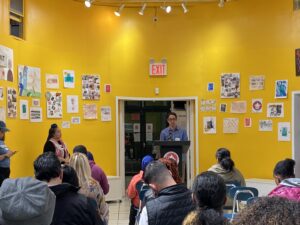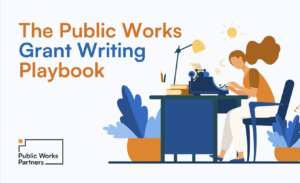When you think of stormwater management, what do you think of? If you thought of water trailing down city streets and flowing into storm drains that lead into a sewer system or local waterways, you’d be right. But that is only one part of the stormwater management puzzle. Green infrastructure and public spaces also play a significant and growing role in helping cities manage stormwater and mitigate flooding.
In 2021, Hurricane Ida hit New York City with a vengeance, shattering the record for the most rainfall in a single hour, which had just been set by Hurricane Henri two weeks prior. This type of extreme storm event – where a lot of rain falls in a short amount of time – is what is known as a cloudburst. Cloudbursts may have devastating impacts on communities. They can cause flooding and property damage, pollute waterways, and disrupt critical infrastructure like transportation, power, and communications. In many cases, conventional methods of stormwater management, such as storm drains and sewer systems, are overwhelmed during cloudburst events, forcing cities to look to unconventional methods for managing stormwater.
Cities around the world are realizing the increasing threat that cloudburst events pose to their communities and are beginning to incorporate cloudburst planning into their climate change adaptation strategies. Among the first to take action was the City of Copenhagen. In response to several extreme storm events, the City of Copenhagen created a Cloudburst Management Plan in 2012. The plan encompasses the implementation of 300 cloudburst planning projects over the course of 20 years. These cloudburst planning projects use a combination of green infrastructure, such as rain gardens and trees, and gray infrastructure, such as roads, sewer pipes, and underground storage tanks. Green-gray infrastructure helps absorb and store excess stormwater to more effectively manage stormwater during and after a cloudburst event, which takes pressure off the sewer system and helps prevent flooding.
New York City drew much inspiration from the City of Copenhagen’s approach to cloudburst planning and the two cities formed a partnership in 2015. Today, New York City is bolstering its efforts to get cloudburst planning projects off the ground. After Hurricane Ida–which led to dozens of deaths across New York, New Jersey, Connecticut, and Pennsylvania–the City committed to constructing four cloudburst neighborhoods, which are areas of the city that are hydraulically connected and vulnerable to flooding from heavy rain. These cloudburst neighborhoods may incorporate combinations of green-gray infrastructure, and may also feature community amenities and open spaces for the public. The City is taking a rigorous approach to identifying priority cloudburst neighborhoods, weighing both physical and socioeconomic vulnerabilities. After all, the effects of extreme rain events do not impact all New Yorkers the same.
Community engagement will be a crucial component of the planning process as the City works to ensure that neighborhoods get the support they need to be prepared for cloudburst events. Unlike other types of flooding that can be predicted based on elevation or proximity to a body of water, cloudburst flooding is more easily exacerbated by human decisions. Litter blocking drainage systems can lead to dangerous conditions, as can living arrangements that are not up to code. Additionally, interventions to mitigate the threat of cloudburst flooding will have physical impacts to the community, and community members should have a say in design decisions, especially regarding public amenities. Identifying areas where conditions that exacerbate cloudburst flooding proliferate, developing strategies to educate community members on the impact of these actions, and building community-based coalitions to support and maintain the new green-gray infrastructure will be essential as the City takes its next steps in cloudburst management.
[author] [author_image timthumb=’on’]https://www.publicworkspartners.com/wp-content/uploads/2021/03/JordanCosby.jpg[/author_image] [author_info]Jordan leads complex multi-stakeholder urban planning engagements to support emergency management projects at Public Works. She brings together expertise in project management, public and nonprofit sector financial management, research, urban policy, and resilience planning in emergency situations. Jordan leverages systems mapping, community needs assessments, and existing conditions analysis to support mitigation planning and long-term vulnerability reduction. She also brings a commitment to building community and partnerships across stakeholder groups through clear and accessible communication strategies.[/author_info] [/author]





 Public Works Partners is a WBE/DBE-certified urban planning and consulting firm. Our expertise lies in creating innovative, equitable, and sustainable solutions to complex problems.
Public Works Partners is a WBE/DBE-certified urban planning and consulting firm. Our expertise lies in creating innovative, equitable, and sustainable solutions to complex problems.